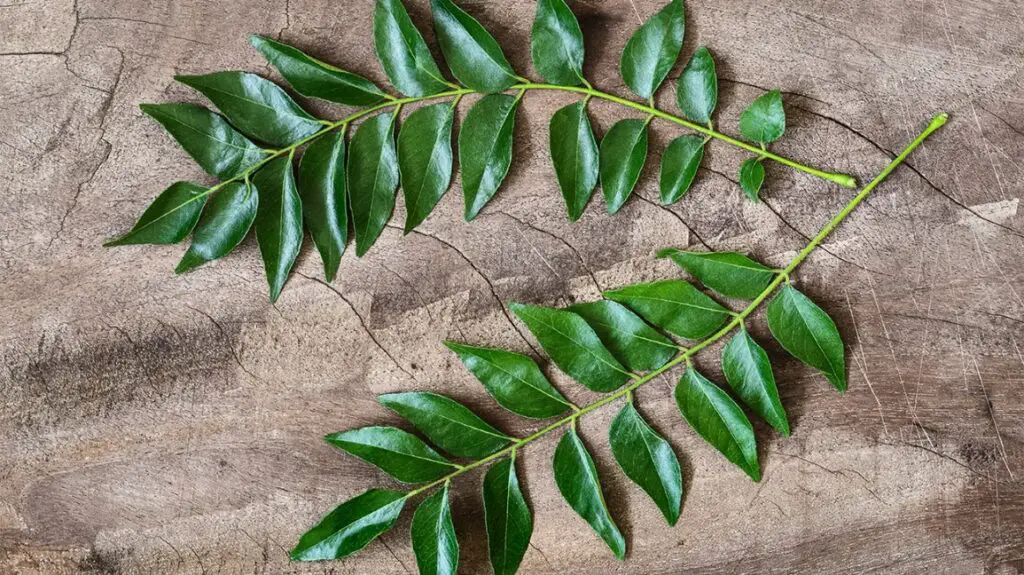The curry leaf plant, known as Bergera koenigii, has many healing properties. This plant is native to Asia. It is also called sweet neem. It belongs to the Rutaceae family.
Description of the Curry Leaf Plant
The curry tree is small. It grows up to 6 meters tall. The trunk can be 40 cm wide. Its leaves are aromatic and pinnate. Each leaf has 11 to 21 leaflets. Each leaflet measures about 2 to 4 cm long.
Flowers And Fruits
The plant produces small, white, fragrant flowers. These flowers can self-pollinate. They produce small, shiny black fruits. Each fruit has one large seed. The pulp of the fruit is sweet and edible.
Distribution and Habitat
The curry leaf plant grows best in well-drained soil. It prefers full sun or partial shade. It thrives in warm temperatures, ideally above 18 °C. The plant is mainly found in the Indian subcontinent.

Etymology and Common Names
The name “curry” comes from the Tamil word kari. This word means “blackened.” The use of curry leaves dates back centuries. They are important in Tamil literature from the 1st to 4th centuries CE.
Culinary Uses of Curry Leaves
Curry leaves are essential in Indian cooking. They add flavor to many dishes. They are often fried with oil, mustard seeds, and onions. This is the first step in many recipes.
- Thoran: A vegetable dish.
- Vada: A savory snack.
- Rasam: A spicy soup.
- Kadhi: A yogurt-based dish.
Curry leaves are also used in spice blends. They are often ground to prepare masalas. One famous masala is sambar masala. This is used in a popular vegetable stew called sambar.
Healing Properties of Curry Leaves
The curry leaf plant has many healing properties. It can help with digestion. It may also lower blood sugar levels. Some studies suggest it helps with cholesterol.
Antioxidant Effects
Curry leaves are rich in antioxidants. These compounds help fight free radicals. This can protect the body from damage.
Anti-inflammatory Benefits
They may reduce inflammation. This is useful for people with joint pain or arthritis.
Antimicrobial Properties
Curry leaves can fight bacteria and fungi. They may help in preventing infections.
Benefits For Hair And Skin
Many people use curry leaves for healthy hair. They can reduce hair loss. They also help in maintaining skin health.

How to Use Curry Leaves in Traditional Medicine
There are many ways to use curry leaves. They can be made into a tea. This tea can help with digestion.
- Curry Leaf Tea: Boil a few leaves in water.
- Powdered Spice: Dry roast and grind leaves for masalas.
- Hair Oil: Infuse curry leaves in coconut oil for hair care.
Frequently Asked Questions
What Are The Benefits Of Curry Leaves?
Curry leaves are rich in antioxidants, promoting overall health and aiding digestion.
How Are Curry Leaves Used In Medicine?
They are used to treat digestive issues, diabetes, and hair health.
Can Curry Leaves Enhance Hair Growth?
Yes, they may strengthen hair follicles and reduce hair loss.
Are Curry Leaves Safe To Consume Daily?
Yes, consuming curry leaves daily is generally safe and beneficial.
Conclusion
The curry leaf plant is important in traditional medicine. Its healing properties and culinary uses are vast. From enhancing flavor in dishes to providing health benefits, it is a valuable plant. Understanding its uses can help many people.
Final Thoughts
Incorporating curry leaves into the diet can be beneficial. They are easy to use and add a unique flavor. The curry leaf plant is not just a spice; it is a treasure of health. Embrace its benefits in your daily life.
References
To learn more about the curry leaf plant, explore the following resources:


